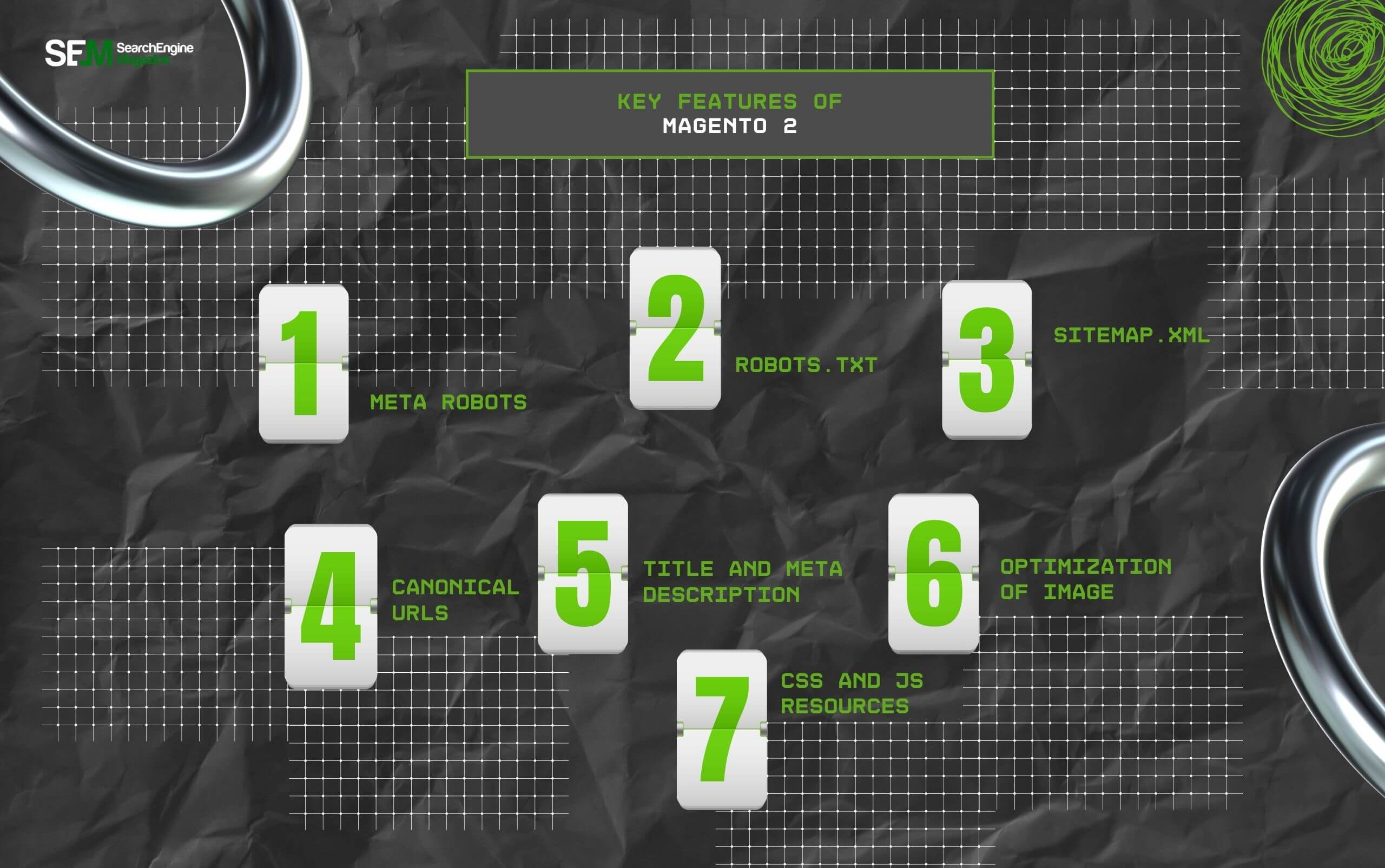Real Estate Link Building That Actually Works: Earn Local Authority, Rankings, and Better Leads Without Spam
Dec 10, 2025

Dec 10, 2025

Dec 10, 2025

Dec 09, 2025

Dec 09, 2025

Dec 05, 2025

Dec 05, 2025

Dec 04, 2025

Dec 04, 2025
Sorry, but nothing matched your search "". Please try again with some different keywords.


The rapid growth of online stores has transformed the digital landscape of e-commerce. Now, customers have more buying options for a single product.
Therefore, it is crucial to stand out from the crowd. And that’s where SEO (Search Engine Optimization) for e-commerce comes into play.
With the right tools and practices, you can optimize your online store page. Making it visible to the search engines and attracting new customers in a jiffy.
And, guess what? Magento provides the perfect platform for that.
By leveraging its SEO features, you can easily drive organic traffic, rank in SERPs, and gain massive online visibility. Taking your online store to the next level.
So, if you are wondering — How to get started with Magento SEO? — have a seat.
Today, I have brought you a complete guide on how you can use Magento 2 SEO for your e-commerce website. From exploring its key features to how to use them, I have covered all the aspects of this SEO beast.
Stay tuned to know more!

Magento SEO is a platform that has improved SEO features for e-commerce stores to help them attract customers, get search engine visibility, and rank on SERPs.
Given that the criteria for ranking evolve every day with new guidelines and tweaks, it is difficult to keep up with them.
But with Magento 2.4.6 version, you get updated SEO features and tools that ease out the process. Giving you the perfect content ranking strategy to improve your digital visibility.
In addition to that, it foucuses on the base URLs and high-quality backlinks, improving your overall SEO performance. So, your website becomes relevant for both users and search engines.
Now, if you are still wondering — “Is Magento SEO friendly?” The answer is, absolutely yes.
With too many platforms in the market, you might get confused, wondering — “Which e-commerce platform is best for SEO?”
Out of the many, Magento and WooCommerce are the top two platforms, offering quality SEO tools and practices for e-commerce stores. But which one to choose?
Well, here are the key differences between them. So that you can choose the one based on your needs.
| Aspects | Magento | WooCommerce |
|---|---|---|
| Built-in Tools | Advanced customization tools for meta tags, URLs, product descriptions, robots.txt, and XML sitemap. | Simple customization tools for meta tags, product descriptions, and titles. And, plugins for advanced features. |
| Meta Tags Customization | Advanced meta tag management system for bulk editing and meta tag automation. | Limited meta tag customization tools. But with Yoast SEO plugins, you can get advanced optimization. |
| Canonical URL Tags | Adds the canonical tags automatically for specific pages. | No built-in support. So, you need the Yoast SEO plugin to add canonical tags. |
| Sitemap Customization | Allows full customization of the XML sitemap. | Limited sitemap customization tools. |
| Schema Markup Support | Supports the complete schema makeup for optimizing structured data with rich snippets. | Need to integrate the Schema Pro plugin for optimizing content. |
| Product Optimization | Customization tools for product titles, images, and descriptions. | No specific customization tool for optimizing product images. |
| Key Metrics Analytics | Built-in SEO performance analytics that measure traffic, keyword performance, and ranking. | Need to integrate Google Analytics to gain insights about SEO performance metrics. |

Only understanding Magento SEO is not enough. You need to have a crisp knowledge of how to implement its features and strategies correctly to enjoy its benefits.
So, here are some of the core areas you can focus on:
It is not new that search engines use bots to crawl through websites. And, indexing your webpage can enable these meta robots to find your product when there’s a search for it.
So, to ensure your page gets visibility on Magento 2, you can go to the Configuration dropdown menu from the Content Design panel.
Then, in the Global Store, expand the Search Engine Robots option and set the Default Robots to Index. This will properly index your online commerce page.
Now, if you want to ensure that your page is crawled for potential keywords, you need to audit the crawled history.
And, in case there are any low-quality pages, just remove the indexing from them.
In addition to this, use the robots.txt to block all the low-value parameters. It will help in prioritizing only the relevant and high search potential pages.
Sitemaps are one of the most crucial files that search engines read through to gather information about your website. Helping them to decide which pages to crawl.
And, with a properly structured sitemap.xml file, you can simplify the entire indexing process. Giving more information about your products and online store to the meta robots.
In Magento 2, you can easily enable the sitemap for your store by following these steps:
To avoid the issue of duplicate content, where your products appear under multiple URLs, you can use canonical URLs.
These ensure that your products have a specific tag. Marking the category or product pages. So, to enable this feature, just follow the steps:
One of the monumental features that distinguishes Magento SEO from its competitors is its meta title and description optimization tool.
So, you get a built-in tool for customizing your titles and product metadata with enriched keywords. Giving them the visibility boost for search engines.
For both product and category page metadata customization, follow the steps below:
Speed plays a great role in driving website traffic. The faster your page loads, the better audience engagement you can expect.
And, this speed is not limited only to the page load times. Faster image loading is crucial, too. So, optimizing your images can help in improving your SEO performance.
And, with the Image Upload Configuration, you can adjust and compress your images. Reducing load times and improving the site’s visibility.
Given that the crawlers read and interpret the JavaScript content of your page, it is essential to optimize the code for proper indexing.
And, Magento’s SEO Audit allows you to identify any JS rendering issues on your page. Based on the audit report, you can minify and optimize the code.
In addition to that, it provides certain merging and minifying tools for the JS resources and CSS files. So that you can compress the code and improve the load times.
For merging the JS and CSS files, you just need to follow the steps below:
Trying the best SEO practices in Magento 2 can drastically improve your SEO performance. And, here’s how to do that.
To manage the SEO of your online store, you need to avoid some of these common mistakes.
Currently, Magento 2 is providing the best SEO strategies and optimization techniques for e-commerce stores. Paving the path for their organic growth and ranking.
However, the platform uses basic and static tools. And, relying only on them won’t offer a striking improvement in your SEO performance overnight.
So, you need to be patient and resilient. Remember, with consistency and regular metrics analysis, you will get the results quickly.
Now that you have the Magento SEO guide right at your fingertips, boost your online visibility and skyrocket your website traffic today!
Barsha is a seasoned digital marketing writer with a focus on SEO, content marketing, and conversion-driven copy. With 7 years of experience in crafting high-performing content for startups, agencies, and established brands, Barsha brings strategic insight and storytelling together to drive online growth. When not writing, Barsha spends time obsessing over conspiracy theories, the latest Google algorithm changes, and content trends.
View all Posts
Real Estate Link Building That Actually Works...
Dec 10, 2025
Why Health-Conscious Consumers Choose Blockch...
Dec 10, 2025
How To Buy Xupikobzo987Model? Decoding The Mo...
Dec 09, 2025
Workplace Management EWMagWork: Is This Smar...
Dec 09, 2025
Social Media Stuff EmbedTree: Is This Digita...
Dec 05, 2025

